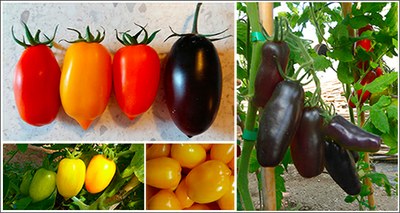Nutrition: New colors, flavors and nutritional properties for San Marzano tomatoes
15/10/2020
 Conventional techniques meet innovative biotechnologies for a 'new' San Marzano tomato, one of the most widespread and popular traditional varieties in Italy and in the world, with new colors, taste and nutritional properties.
Conventional techniques meet innovative biotechnologies for a 'new' San Marzano tomato, one of the most widespread and popular traditional varieties in Italy and in the world, with new colors, taste and nutritional properties.
A team of researchers from ENEA, CREA and the Universities of Valencia and Tuscia (coordinator), has "redesigned" this symbol of the Campania region from an aesthetic, organoleptic and nutritional point of view, maintaining unaltered the typical, traditional characteristics conveyed by the Vesuvius volcanic soil on which it grows, in the Agro Nocerino-Sarnese area, in the Province of Naples.
Specifically, the researchers characterized 18 lines of the San Marzano berry (with single or multiple mutations) responsible for the content of pigments such as carotenoids, chlorophyll, flavonoids and the ripening process. The University of Tuscia improved the vegetative, reproductive and genetic aspects of the fruit. ENEA on the other hand, focused on metabolomic analysis, i.e. the chemical characterization of the fruits of San Marzano genotypes, with particular reference to the molecules associated with color and taste.
In this way, each mutation developed specific organoleptic and nutritional properties. For example, while yellow tomatoes are not as anti-oxidant due to the lower lycopene content, they acquire amino acids, vitamins, xanthophylls and quinones. Brown tomatoes acquire chlorophyll, which is generally absent in red fruits, and higher sugar and vitamin E content, while purple ones acquire anthocyanins" Gianfranco Diretto, at the ENEA Biotechnology Laboratory explained. The study was published on the magazine Metabolites (Dono et al., 2020b).
“The results will be used for future research that, also by using innovative technologies such as genome editing, will generate new tomato varieties in a quicker and safer manner compared to classic hybridization programs” Andrea Mazzucato at the University of Tuscia in Viterbo said.
ENEA, with its specialized skills and advanced technological platforms on genetics, molecular biology, omics sciences, infrastructures and long standing experience, has been active for years in the sector of advanced biotechnologies with its laboratories conducting research and development activities aimed at enhancement, sustainability and competitiveness of agri-food (green biotech), pharmaceutical (red biotech) and nanotechnological (nano biotech) productions, for the construction of new model plant types, biopharmaceuticals, nutraceuticals and plants resistant to biotic and abiotic stress.
The activities were conducted with the support of various funding bodies including the Lazio Region (project FILAS "MIGLIORA"), the Ministry of Agriculture (MiPAAF, Agroener Project), the Ministry of Education, University and Research (MIUR ), The European Commission, COST-Action Eurocaroten and the Interuniversity Consortium for Biotechnology (CIB).
For more information please contact:
- Gianfranco Diretto, ENEA – Biotechnology Laboratory - email: gianfranco.diretto@enea.it
- Andrea Mazzucato, - Department of Agricultural and Forestry Science University of Tuscia - email: mazz@unitus.it
Link to the articles:
https://www.sciencedirect.com/science/article/abs/pii/S0304423819308131
